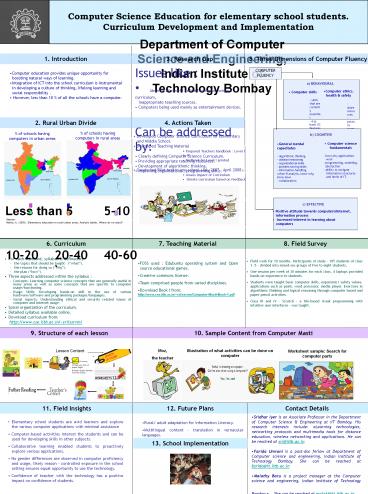Computer Science Education for elementary school students. - PowerPoint PPT Presentation
1 / 1
Title:
Computer Science Education for elementary school students.
Description:
Computer Science Education for elementary school students. Curriculum Development and Implementation Department of Computer Science and Engineering, Indian Institute ... – PowerPoint PPT presentation
Number of Views:137
Avg rating:3.0/5.0
Title: Computer Science Education for elementary school students.
1
Computer Science Education for elementary school
students. Curriculum Development and
Implementation
Department of Computer Science and Engineering,
Indian Institute of Technology Bombay
1. Introduction
3. Research Gap
5. Three Dimensions of Computer Fluency
- Issues like
- Absence of clearly defined computer science
curriculum, inappropriate teaching sources. - Computers being used mainly as entertainment
devices. - Can be addressed by
- Clearly defining Computer Science Curriculum.
- Providing appropriate teaching resources.
- Development of algorithmic thinking.
- Improving organisational, programming skills.
COMPUTER FLUENCY
- Computer education provides unique opportunity
for boosting natural ways of learning. - Integration of ICT into the school curriculum is
instrumental in developing a culture of
thinking, lifelong learning and social
responsibility . - However, less than 10 of all the schools have
a computer.
a) BEHAVIOURAL
- Computer ethics, health safety
- share resources
- posture exercises
- Internet safety
- Computer skills
- skills that are currently essential
- e.g. basic OS features, Internet
2. Rural Urban Divide
4. Actions Taken
of schools having computers in rural areas
of schools having computers in urban areas
- Developed Computer Science Curriculum for
Elementary and Middle School. - Developed Teaching Material
- Prepared Teachers handbook Level I to IV
- Textbook for Level I printed
- Conducted Pilot test in one school (July 2007
April 2008). - Assess impact of Curriculum
- Iterate curriculum based on feedback
c) EFFECTIVE
- Positive attitude towards computers/Internet,
- information process
- Increased interest in learning about
computers
Source Mehta, A. (2005). Elementary education in
rural/urban areas Analytic tables. Where do we
stand?
6. Curriculum
8. Field Survey
7. Teaching Material
- Field work for 10 months. Participants of study
105 students of class 1 -5 - divided into
mixed-sex groups of five to eight students. - One session per week of 30 minutes for each
class, 4 laptops provided hands-on experience to
students. - Students were taught basic computer skills,
ergonomic/ safety values, applications such as
paint, word processor, media player. Exercises in
algorithmic thinking and logical reasoning
through computer based and paper-pencil
activities. - Class III and IV - Scratch - a tile-based visual
programming with intuitive user interfaces - was
taught.
- For each standard, syllabus is defined by
- the topics that should be taught (what).
- the reasons for doing so (why).
- the plan (how).
- Three aspects addressed within the syllabus
- Concepts Learning computer science concepts that
are generally useful in many areas as well as
some concepts that are specific to computer
usage/functioning. - Usage Skills Developing hands-on skill in the
use of various hardware/software and programming
packages/languages. - Social Aspects Understanding ethical and
security related issues of computer and Internet
usage. - Spiral organization of the curriculum.
- Detailed syllabus available online.
- Download curriculum from
- http//www.cse.iitb.ac.in/sri/ssrvm/
- FOSS used Edubuntu operating system and Open
source educational games. - Creative commons license.
- Team comprised people from varied disciplines.
- Download Book I from http//www.cse.iitb.ac.in/s
ri/ssrvm/Computer-Masti-Book-1.pdf
9. Structure of each lesson
10. Sample Content from Computer Masti
11. Field Insights
12. Future Plans
Contact Details
- Sridhar Iyer is an Associate Professor in the
Department of Computer Science Engineering at
IIT Bombay. His research interests include
eLearning technologies, networking protocols and
multimedia tools for distance education, wireless
networking and applications. He can be reached at
sri_at_iitb.ac.in - Farida Umrani is a post-doc fellow at Department
of Computer science and engineering, Indian
Institute of Technology Bombay. She can be
reached at farida_at_it.iitb.ac.in - Malathy Baru is a project manager at the Computer
science and engineering, Indian Institute of
Technology Bombay. She can be reached at
malati_at_it.iitb.ac.in
- Elementary school students are avid learners
and explore the various computer applications
with minimal assistance - Computer-based activities interest the students
and can be used for developing skills in
other subjects. - Collaborative learning enabled students to
proactively explore various applications. - No gender differences are observed in computer
proficiency and usage, likely reason -
controlled exposure in the school setting
ensures equal opportunity to use the technology. - Confidence of teacher with the technology has a
positive impact on confidence of students.
- Rural/ adult adaptation for Information Literacy.
- Multilingual content translation in vernacular
languages.
13. School Implementation































